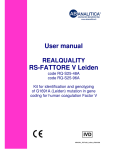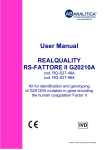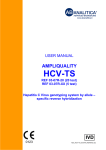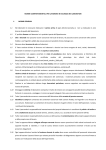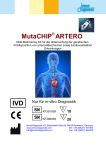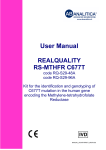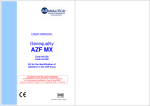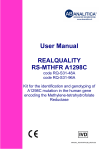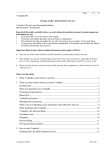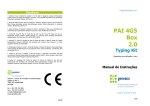Download AB-THROMBO TYPE PLUS
Transcript
USER MANUAL GENEQUALITY AB-THROMBO TYPE PLUS code 04-71A Kit for the simultaneous detection and identification of mutations in the genes coding for Factor II, Factor V, and MTHFR and PAI-1 by allele-specific hybridization (reverse line blot). THROMBO-TYPE_PLUS_04-71A_manual_eR260310.doc 1. PRODUCT INFORMATION 3 1.1. Intended Use 3 2. KIT CONTENT 4 3. STORAGE AND STABILITY OF THE REAGENTS 6 4. PRECAUTIONS FOR USE 6 5. SAFETY RULES 8 5.1. General safety rules 8 5.2. Safety rules about the kit 9 6. MATERIALS REQUIRED, BUT NOT PROVIDED 10 6.1. Reagents 10 6.2. Instruments 10 6.3. Materials 10 7. INTRODUCTION 11 8. TEST PRINCIPLE 14 9. PRODUCT DESCRIPTION 15 10. COLLECTION, MANIPULATION, AND PRE-TREATMENT OF THE SAMPLES 17 11. PROTOCOL 11.1. 17 DNA extraction 17 11.2. AMPLIFICATION of the relevant portions of thrombosis-related genes 11.2.1. Multiplex Amplification 17 17 11.3. Reverse hybridization 11.3.1. Preliminary Steps 19 19 11.4. Denaturation and Hybridization 19 11.5. Staining Protocol 20 12. INTERPRETATION OF THE RESULTS THROMBO-TYPE_PLUS_04-71A_manual_eR260310.doc 1 22 12.1. Quality Control 22 12.2. Interpretation 22 13. TROUBLESHOOTING 23 14. DEVICE PERFORMANCE 26 14.1. Analytical sensitivity 26 14.2. Analytical specificity 26 14.3. Accuracy 26 15. DEVICE LIMITATIONS 27 16. REFERENCES 27 17. SHORT PROTOCOL FOR DETECTION ON STRIPS: FAST GUIDE 28 2 THROMBO-TYPE_PLUS_04-71A_manual_eR260310.doc 1. PRODUCT INFORMATION 1.1. Intended Use GENEQUALITY AB-THROMBO TYPE PLUS is an IVD for simultaneous detection and identification of most relevant thrombosis-related mutations, by means of reverse line blot technique. In particular, this IVD is designed for detection and genotyping of the mutations: Factor V Leiden G1691A (Arg505Gln), Factor V H1299R (Haplotype HR2), Factor II G20210A, MTHFR C677T, MTHFR A1298C, and PAI-1 for the polymorphism 4G/5G, and it is an auxiliary device for diagnostics and evaluation of potential thrombophilic patients. It is recomended to follow the instructions herein for the use of this device. This user manual describes the instructions for use of the following products: GENEQUALITY AB-THROMBO TYPE PLUS Includes reagents for the amplification and visualization of the amplified products by reverse line blot. Code 04-71A-20 Product AB-THROMBO TYPE PLUS THROMBO-TYPE_PLUS_04-71A_manual_eR260310.doc 3 PKG 20 tests 2. KIT CONTENT BOX P code 04-71A STORE AT – 30°/–20°C DESCRIPTION X Single dose premix tubes for multiplex amplification X Super AB Taq Thermostable DNA polymerase LABEL Super AB TAQ 5 U/L TUBE (T) OR LID COLOR 20 tests 5 tests Orange (T) 20 5 Red 1 x 25 L 1 x 5 L SMALL BAG code 04-71A STORE AT – 30°/–20°C X DESCRIPTION Reference DNA LABEL TUBE (T) OR LID COLOR 20 tests 5 tests Reference DNA Blue 1 x 15 L 1 X 5 L 4 THROMBO-TYPE_PLUS_04-71A_manual_eR260310.doc BOX R code 04-71A STORE AT +2°/ +8°C X X LABEL IDENTIFICATION COLOR 20 tests 5 tests AB-THROMBO-TYPE PLUS STRIP Orange 20 5 White 1 X 1 mL 1 X 1mL HYB-1 Red 1 X 25 mL 1 X 25 mL CON-D2 Yellow 1 X 50 mL 1 X 50 mL CONJUGATE Yellow 1 X 15 L 1 X 15 L RIN Green 1 X 50 mL 1 X 50 mL NBT/BCIP Tinted bottle 4 tablets 1 tablet STOP Blue 1 X 25 mL 1 X 25 mL DESCRIPTION Nylon strips with specific probes DEN Xi:irritant Ready-to-use Denaturation solution Contains NaOH < 2% R 36/37/38 S26 X Ready-to-use Hybridization solution X Conjugate Diluent X Streptavidin Conjugate with Alkaline Phosphatase X Ready-to-use Rinse Solution X Substrate: NBT/BCIP tablets for dissolving in water X Ready-to-use Stop Solution containing Citric acid < 0.5% X Tray with 8 disposable incubation channels each for hybridizing and staining 3 1 X Transparent film for reading the strip and interpreting the results 1 1 X Strip collection sheet 2 1 THROMBO-TYPE_PLUS_04-71A_manual_eR260310.doc 5 3. STORAGE AND STABILITY OF THE REAGENTS Each component of the kit must be stored according to the directions indicated on the label of each package, in particular: Box P Small Bag Box R Store at –30°C / –20°C Store at –30°C / –20°C Store at +2 - +8°C If stored at the recommended temperature, all test reagents are stable until their expiration date indicated on the labels. 4. PRECAUTIONS FOR USE This product is for IN VITRO use only; The kit should be handled by qualified investigators who are educated and trained in molecular biology techniques applied to diagnostics; Before starting the kit procedure, read carefully and completely the instruction manual; Keep the product away from heat sources; Do not use any part of the kit past the expiration date; In case of any doubts or questions about the storage conditions or box integrity, contact AB ANALITICA’s technical support at: [email protected]; The room temperature should be between +15°C and +28°C and the humidity should be between 20% and 80% during all the procedures. Temperatures and humidity that do not respect these ranges can lead to invalid results. In this case the test must be repeated; It is important to include in each experiment negative and positive controls; 6 THROMBO-TYPE_PLUS_04-71A_manual_eR260310.doc It is absolutely necessary to dose exactly the amount of reagents in each step to obtain a good performance of the method. In case of multiple samples, be sure that the total amount of the mixture is exact; Nucleic acids are easily degraded by nucleases found in the environment and on the operator’s skin: always wear a coat and gloves; Use sterile filter-tips; Do not use or mix reagents from different lots; Thaw each component well; Once the components have thawed after being removed from –30°C /– 20°C, Remove the necessary material and put back immediately at the indicated temperature in order to avoid degradation of the reagents; do not leave these components for more than 1 hour at + 2-+ 8°C Organize the space into different areas: extraction, amplification, and detection; do not share instruments and consumables (pipettes, tips, tubes, etc) between them; Keep the reagents away from extracted DNA samples; Avoid microbial contamination in the reagents; Wash the work bench surfaces with 5% sodium hypochloride; BCIP/NBT must not be exposed to direct light because it degrades easily. THROMBO-TYPE_PLUS_04-71A_manual_eR260310.doc 7 5. SAFETY RULES 5.1. General safety rules Wear disposable gloves to handle the reagents and the clinical samples and wash your hands at the end of work; Do not pipette with the mouth; Since, no known diagnostic method can assure the absence of infective agents, it is a good rule to consider every clinical sample as potentially infectious and handle it as such; All the devices that directly touch the clinical samples must be considered as contaminated and disposed as such. In case of accidental spilling of the samples, clean up with 10% Sodium Hypochloride. The materials used to clean up must be disposed of in special containers for contaminated products; Clinical samples, materials, and contaminated products should be disposed of after decontamination by: immersion in a solution of 5% Sodium Hypochloride (1 volume of 5% Sodium Hypochloride solution for every 10 volumes of contaminated fluid) for 30 min. OR autoclave at 121°C for at least 2 hours (NOTE: do not autoclave solutions containing Sodium Hypochloride!!) 8 THROMBO-TYPE_PLUS_04-71A_manual_eR260310.doc 5.2. Safety rules about the kit The risks derived from this product are associated to the single components. Dangerous components: DEN SOLUTION: contains NaOH <2% Description of risk: Causes severe burns RISK SENTENCES AND S SENTENCES R 36/37/38 S 26 Eye, respiratory tract, and skin irritant; In case of eye contact, wash immediately with an abundant amount of water and consult a medical doctor. Material safety data sheet (MSDS) of the kit is available upon request. THROMBO-TYPE_PLUS_04-71A_manual_eR260310.doc 9 6. MATERIALS REQUIRED, BUT NOT PROVIDED 6.1. 6.2. Reagents DNA extraction reagents; Sterile DNase and RNase free water; Distilled water; 96%-100% ethanol. Instruments Laminar flow cabinet (use is recommended while adding TAQ polymerase to the amplification premix to avoid contamination; it would be recommended to use another laminar flow cabinet to add the extracted DNA); Micropipettes (range: 0.5-10 µL; 2-20 µL; 20-100 µL; 100-1000 µL); Thermalcycler; Microcentrifuge (max 12-14,000 rpm); Automatic pipettor and sterile graduated pipettes; Aspirating system for liquids in the hybridization bath; Orbital shaker; Thermoshaker or thermobath (Dubnoff) able to reach and maintain 46°C ± 0.5°C. 6.3. Materials Disposable gloves; Disposable sterile filter-tips (range: 0.5-10 µL; 2-20 µL; 20-100 µL; 100-1000 µL); 1.5 mL Eppendorf-type tubes; 50 mL Falcon-type tubes for preparing the solutions for the reverse line blot steps. Forceps for strip handling. 10 THROMBO-TYPE_PLUS_04-71A_manual_eR260310.doc 7. INTRODUCTION Venous thrombosis is the obstruction of the circulation by clots that have been formed locally in the veins or have been released from a thrombus elsewhere formed. The usual sites of thrombus formation are the superficial and deep veins of the legs, but it also may occur in veins in the brain, retina, liver, and mesentery. An important question is whether the risk for the development of venous thrombosis can be predicted. Apart from the local activation of the coagulation system by e.g., trauma, surgery, immobilization, pregnancy and use of oral contraceptives, also the genetic background of an individual plays an important role. An increased risk of venous thrombosis can last throughout life because of the presence of mutations in genes encoding proteins, involved in the haemostatic or fibrinolytic processes. At present, several mutations that play an important role in the development of venous thrombosis have been identified in the following genes: FACTOR II, FACTOR V, MHTFR (methylentetrahydrofolate reductase), and activator inhibitors of the type 1 plasminogen (PAI-1). Factor V gene codes for the homonym protein which is present in the blood as inactive pro-cofactor. It can be activated by thrombin, resulting in the formation of a two-chain molecule (factor Va) that serves as a cofactor of factor Xa in the conversion of prothrombin into thrombin. Inactivation of factor Va occurs through selective proteolytic cleavages in its heavy chain at Arg306, Arg506, and Arg679 by activated protein C (APC). The hypothesis is that thrombosis can result from a variety of genetic mutations affecting critical sites in the factor V protein. A G-A transition in exon 10 of the FACTOR V gene results in the replacement of arginine at position 506 by glutamine in the resulting protein. This mutated form of factor V is known as the Factor V Leiden mutant. The activated factor V Leiden is not cleaved by APC, and is therefore designated APCresistant. This is the molecular basis of the laboratory phenotype of APC resistance (Bertina et al., 1994). The population of carriers of factor V Leiden in the white population ranges from 2 to 15 percent. The mutation is extremely rare in non-whites. Heterozygous carriers have a risk of deep venous thrombosis that is 7 times higher than that in the general population; for homozygous carriers, the risk is 80 times as high. Prothrombin, or Factor II, is the inactive precursor of thrombin. The gene comprises a 5’UTR, 14 exons with 13 introns, and a 3’UTR. Recently, a common genetic variation was found in the 3’UTR that is associated with elevated prothrombin levels and an increased risk of venous thrombosis THROMBO-TYPE_PLUS_04-71A_manual_eR260310.doc 11 (Poort et al., 1996). The importance of this G-A transition at nucleotide 20210 is not yet fully understood, but several investigators have reported that heterozygous carriers have a 30 percent higher plasma prothrombin levels than noncarriers and have a risk of deep-vein thrombosis that is 3-6 times higher than that in the general population. Again, the mutation is rare among nonwhites. In whites, the carrier rate ranges from 0.7 to 4 percent. G20210A appears to be an important risk factor for cerebral-vein thrombosis. Furthermore, the G20210A mutation seems to be synergistic with the use of oral contraceptives. The HR2 haplotype of the Factor V, is made up of a polymorphism (A4070G) in exon 13 of the FV, substituting a histidine (allele R1) with a arginine (allele R2) in the 1299 position of the B domain of the FV (H1299R). Different aimed studies at the valuation of its association with the APCresistance phenotype and thrombotic phenotypes demonstrated HR2 as a prothrombotic risk factor confirmable by a significant lowering of the in vitro APC-ratio values and an prothrombotic risk increase in those individuals who inherited in trans the HR2 haplotype and the FV Leiden mutation. Further, individuals with the HR2 haplotype have an increase relative to the most thrombogenic and glycosylated isoform of the FV (Gemmati et al., 1999). Hyperhomocysteinaemia has been identified as a risk factor for cerebrovascular, peripheral vascular and coronary disease. Elevated levels of plasma homocysteine can results from genetic or nutrient-related disturbances in the trans-sulphuration or re-methylation pathways for homocysteine metabolism. N5,N10-methylenetetrahydrofolate reductase (MTHFR) catalyses the reduction of N5,N10-methylenetetrahydrofolate to N5methyltetrahydrofolate. Reduced MTHFR activity has been reported in patients with coronary and peripheral artery disease. The C677T mutation in the MTHFR gene represents the most common hereditary defect in the homocysteine metabolysm. A corresponding alanine to valine substitution at the 223 position of the protein results in a production of a thermolabile variant of the enzyme, with reduced specific activity. This, in turn, establishes the hyperhomocysteinaemia conditions, especially at the low folate levels (Gemmati et al., 1999). Also another MTHFR mutation, A1982C, was found to be correlated with lower enzyme activity. The inhibitor of the type 1 plasminogen activator (PAI-1) is a glycoprotein that acts as an inhibitor of the plasminogen activation process in the blood and has a ket role in the formation of stable clots. High levels of this inhibitor have been associated with a higher thrombotic risk for both artery (myocardiac heart attacks and coronary artery disease). 12 THROMBO-TYPE_PLUS_04-71A_manual_eR260310.doc At the level of the promoter region of the PAI-1 gene, it has an insertion/deletion polymorphism (SNP) of a single G (4G/5G) at the position 675 at the beginning of the gene, in the promoter. The promoter with the 4G mutation is able to bind only an transcription enhancer while the 5G allele is able to bind both the enhancer and the suppressor; this translates in a lower transcription level in the presence of the 5G allele. Numerous studies have demonstrated that carriers of the homozygote 4G allele have a PAI-1 plasmatic level 25% higher than homozygote 5G individuals, consequently with a risk for coronary diseases, and in pregnant women a higher risk of preeclampsia (Dawson, 1993). Presence of multiple mutations may have synergistic effects. Therefore it is advantageous to perform simultaneous testing. THROMBO-TYPE_PLUS_04-71A_manual_eR260310.doc 13 8. TEST PRINCIPLE PCR (Polymerase Chain Reaction) was the first method of DNA amplification described in literature. (Saiki RK et al., 1985). It can be defined as an in vitro amplification reaction of a specific part of DNA (target sequence) by a thermo-stable DNA polymerase. In the reaction, three segments of nucleic acid are involved: the double strand DNA template to be amplified (target DNA) and two single-strand oligonucleotides “primers” that anneal in a specific manner to the template The DNA polymerase begins the synthesis process at the region marked by the primers and synthesizes new double stranded DNA molecules, identical to the original double stranded target DNA region, by facilitating the binding and joining of the complementary nucleotides that are free in solution (dNTPs). After several cycles, we can get millions of DNA molecules which correspond to the target sequence The sensitivity of this test and short procedure time make it particularly suitable for the application in laboratory diagnostics. The subsequent hybridization of the labelled amplified product with specific probes immobilised on a strip (allele specific hybridization/ Reverse Line blot) can distinguish different mutations. There are several methods for labeling the amplification products, by using radioactive, digoxigenin or biotinylated nucleotides during the amplification process. These nucleotides can be added to the reaction mix or simply included in the primers. The allele-specific hybridization technique is a hybridization technique on solid phase and represents the most appropriate method for the visualization of hybridized nucleic acids (Meinkoth e Wahl, 1984). There are many kinds of filters for immobilization of nucleic acids now available on the market: nitrocellulose, with high capacity of single strand DNA binding (not covalent) (80 µg cm-2 for strands longer than 500 nucleotides) but fragile in presence of acids and alkali; nylon, with high capacity of single strand DNA binding (either covalent or not) (> 400 µg cm-2), but able to bind also double stranded DNA and oligonucleotides; positive charged nylon, with quaternary ammonium groups (positively charged) which have the advantage of binding covalently and irreversibly to the denatured DNA in alkaline conditions. 14 THROMBO-TYPE_PLUS_04-71A_manual_eR260310.doc Nucleic acid hybridization on the filter is obtained by these passages: denaturation: of the labeled amplification product, by incubation at 95°C or chemical denaturation; hybridization: the membrane (strip) is incubated with the solution containing the labeled amplification product, under specific conditions of temperature, shaking and pH; washings: washings are necessary to remove the excess of labeled product, to set the hybridization “stringency”; Detection of the hybrid formed: depends on the type of probe employed. 9. PRODUCT DESCRIPTION The GENEQUALITY AB-THROMBO TYPE PLUS kit is based on the reverse hybridization principle. The relevant parts of the genes coding for the factors are amplified by multiplex PCR by means of biotinylated primes. The resulting biotinylated amplicons are denatured and hybridized with specific oligonucleotide probes, which are immobilized as parallel lines on membrane strips (FIG.1). After hybridization and stringent washing, streptavidin conjugated alkaline phosphatase is added and bound to any biotinylated hybrid previously formed. Incubation with BCIP/NBT chromogen yields in a purple precipitate and the results can be visually interpreted. The mutations identifiable by this kit are: Factor II G20210A, Factor V Leiden G1691A (Arg505Gln), Factor V H1299R (haplotype HR2), the mutations C677T and A1298C of the MTHFR and the polymorphsm 4G/5G for PAI-1; the result interpretation will allow to evaluate its status (homozygote, heterozygote, genetic compound). A positive control for both the amplification and the genotyping step is included in the kit. This reference DNA displays the following genotype arrangement: Factor II G20210A WT Factor V Leiden G1691A WT Factor V (haplotype HR2) H1299R WT MTHFR MTHFR C677T A1298C HET HET PAI-1 4G/5G HET The successful amplification and genotyping of the positive control guarantees that the reaction functioned correctly. THROMBO-TYPE_PLUS_04-71A_manual_eR260310.doc 15 The kit is in premix format: the multiplex amplification reagents are pre-mixed and aliquoted in single dose test tubes, which only Taq polymerase and the extracted DNA will be added to. This premix format reduces the manipulation steps in pre-amplification, saves considerable time for the operator, avoids repeated freezing/thawing of reagents (that could alter the product performances) and, above all, this format reduces significantly the risk of contamination and the risk of obtaining false positive results. For this purpose, it is always recommended to use all the proper amplification controls. Controllo di colorazione Fattore II WT Fattore II MUT Fattore V Leiden WT Fattore V Leiden MUT Fattore V HR2 WT Fattore V HR2 MUT MTHFR 677 WT MTHFR 677 MUT MTHFR 1298 WT MTHFR 1298 MUT PAI-1 WT PAI-1 MUT Figure 1: Location of the specific probes on the thrombo-strip. A line is drawn on the top of the strip for orientation 16 THROMBO-TYPE_PLUS_04-71A_manual_eR260310.doc 10. COLLECTION, MANIPULATION, TREATMENT OF THE SAMPLES AND PRE- The search of mutations of the genes involved in thrombosis is performed starting from whole peripheral blood. Sample collection should follow all the usual sterility precautions. Blood must be treated with EDTA. Other anti-coagulating agents, as heparin, are strong inhibitors of TAQ polymerase and so they could alter the efficiency of the amplification reaction. Fresh blood can be stored at +2/+8°C (processed within 4 hours from the collection); if DNA is not shortly extracted, the sample must be frozen at 20°C. 11. PROTOCOL 11.1. DNA EXTRACTION Any DNA extraction method can be used, provided that it allows for the extraction of pure and integral DNA. For any further information or explanations regarding the extraction method contact AB ANALITICA’s technical support at: [email protected], fax +39 049-8709510, or tel. +39 049-761698. 11.2. AMPLIFICATION of the relevant portions of thrombosi genes ATTENTION: The premixed tubes may be placed in a couple of sponges placed one on top of the other. 11.2.1. Multiplex Amplification To each ready-to-use premixed tube add: Super AB Taq 0.25 µL DNA 3 L VFINAL 50 µL THROMBO-TYPE_PLUS_04-71A_manual_eR260310.doc 17 ATTENTION: add 2 drops of mineral oil (not supplied) if indicated in the thermalcycler manual. It is important to include in each experiment a negative control to monitor contaminations (add distilled water to the mix instead of extracted DNA), and a positive control (3 L of positive control included in the kit). Centrifuge briefly, then put the microtubes in the thermalcycler, programmed as below: 1 cycle 95°C 5 minutes 10 cycles 95°C 60°C 20 seconds 2 minutes 25 cycles 95°C 58°C 72°C 25 seconds 40 seconds 40 seconds 1 cycle 72°C 5 minutes Amplification product dimensions: Factor II 112 bp Factor V Leiden 154 bp Factor V HR2 127 bp MTHFR 677 102 bp MTHFR 1298 105 bp PAI-1 4G/5G 129 bp The obtained amplification product should be immediately employed in the hybridization step or stored at –30°/ –20° C until its use. 18 THROMBO-TYPE_PLUS_04-71A_manual_eR260310.doc 11.3. REVERSE HYBRIDIZATION 11.3.1. Let the kit reach the room temperature prior to use Heat the bath or the thermalshaker at 46°C and ensure it mantains the given temperature during the entire procedure with an +/- 0.5°C error; Preheat the HYB-1 solution and the CON-D2 solution at 46°C in the bath or in the thermalshaker. Number each strip above the black positioning line with a pencil. 11.4. Preliminary Steps Denaturation and Hybridization Mix in a tube: Amplicon 10 uL Denaturation Solution 20 uL Incubate for 5 min at room temperature. In the meantime, remove the strips with tweezers and number them above the positioning line with a pencil. Always wear gloves when handling the strips. Place the tray in the thermobath, paying attention it doesn’t float (the water of the thermobath must absolutely not enter inside the tray); Add 1 mL of preheated HYB-1 Solution to each used channel and place a strip in each one with the tweezers. The strips must be completely immersed in the solution and the side that has the probes attached (identifiable by the presence of a black line) must be facing up. In case the strip is upside down use the tweezers to put it in the correct orientation. Add 30 µL of denatured amplification product to each channel; Incubate for 30 minutes at 46°C, agitating delicately (agitation speed ≤ 250 RPM). THROMBO-TYPE_PLUS_04-71A_manual_eR260310.doc 19 11.5. Staining Protocol Before the end of incubation with stringent wash, prepare the dilution of the conjugate in the following way: For N samples mix: - N x 0.5 µL CON Solution - N x 1 mL CON-D2 Solution (preheated) Aspirate all the hybridization liquid and add 1 mL of preheated CON-D2 solution, place the tray in the thermobath again for 2 minutes at 46°C under agitation . Aspirate all the liquid from the channels and add 1 mL of streptavidinealcaline conjugate previously diluted in CON-D2 solution, place the tray in the thermobath again for 30 minutes at 46°C under agitation. Meanwhile, prepare the Stain Solution as indicated below: dissolve 1 tablet of NBT/BCIP in 10 mL of distilled water Attention: The quantity of stain solution obtained from one dissolved tablet of NBT/BCIP is sufficient for 10 strips! The obtained stain solution must be stored in the dark. It is preferable to use a fresh solution, but if this is not possible it can be stored in the freezer at –30°C / –20°C for no more than 3 days in complete darkness (it is recommended to wrap the tube with aluminium foil). The frozen solution is reusable for only one cycle of freezing/thawing. The preparation of the Stain Solution directly from the tablets avoids the handling of the formammide (a toxic compound contained in the chromogens when in the liquid state). At the end of incubation with the conjugate aspirate all the liquid and wash with 1 mL of RIN Solution. Agitate the tray at room temperature for 2 minutes. Aspirate all the liquid and wash again with 1 mL of RIN Solution for 2 minutes at room temperature under agitation. Empty the tray and add 1 mL of Stain Solution prepared previously. Incubate for 5-8 minutes in the dark at room temperature. The incubation time can vary depending on the environmental conditions (ex. 20 THROMBO-TYPE_PLUS_04-71A_manual_eR260310.doc location temperature) and the quantity of the amplified product present. A prolonged incubation time can cause an increase in the background staining, which can interfere with the interpretation of the results. Empty the tray and stop the staining reaction by washing for 2 minutes with 1 mL of STOP Solution. Aspirate the liquid and wash for 2 minutes with distilled water. Remove the strips from the trays with the tweezers and let them dry between two pieces of paper towel. This procedure guarantees the removal of possible residual background staining, that is visible on the wet strips Once the strips have been dried, they can be stored in the dark for years. THROMBO-TYPE_PLUS_04-71A_manual_eR260310.doc 21 12. INTERPRETATION OF THE RESULTS Cover each strip with the transparent film (included in the kit), and align the Staining Control with the one present on the strip. 12.1. Quality Control The first positive band (located immediately under the positioning line) is the conjugate control band or the staining control band. This band indicates the binding of the conjugate to the substrate during the detection procedure. This band must always be present and must have aproximately the same intensity in each strip. 12.2. Interpretation A positive reaction is represented by a clearly visible band. Identify all the positive bands on the strip and determine the diagnostic pattern by using the transparent reading film and the following table: Bands (1) Probe reactivity (conjugate control band: must always be positive!) 2 3 Factor II wildtype Factor II mutant G20210A 4 5 Factor V wildtype Factor V Leiden mutation G1691A (Arg506Gln) 6 7 Factor V HR2 wildtype Factor V HR2 mutation H1299R 8 9 MTHFR wildtype MTHFR mutant C677T 10 11 MTHFR wildtype MTHFR mutant A1298C 12 13 PAI-1 wildtype PAI-1 mutant 4G/5G 22 THROMBO-TYPE_PLUS_04-71A_manual_eR260310.doc REPORT: It has been reported that sometimes the bands can assume a partial or complete light blue staining, that does not affect the interpretation of the results. 13. TROUBLESHOOTING 1. Weak or no bands at all, and absence of the staining (conjugate) control band, in all of the strips. Probably an inadequate quantity of the conjugate or the substrate was used during the staining steps. Repeat the staining step with a new conjugate and a new substrate solution, on the same strips. Room temperature is less than 20°C. Heat the work space properly. 2. False negative signals or too weak signals, except for the staining (conjugate) control band. Too high temperature during the hybridization or the stringent wash steps. Check the bath temperature accurately during the hybridization and stringent wash steps. The HYB-1 or the CON-D2 solutions were not properly heated and mixed before use. Heat and mix the HYB-1 and the CON-D2 solutions properly before use. The amplification step was inefficient and the amplicon added to the strips is too diluted. Check for the presence of an apropriate amplification product in a 3% agarose gel. Load 10 l of the amplification product on the gel. The THROMBO-TYPE_PLUS_04-71A_manual_eR260310.doc 23 amplification products that are visibile (positive) in the gel electrophoresis must also be positive on strip. Repeat the amplification step and add more target DNA. The DNA solution is not pure ( A260/A280 ratio for the extracted DNA is very low). Check if the extraction protocol was performed properly and repeat the extraction step starting from a new sample. An RNA residue is present in the extracted DNA ( A260/A280 ratio for the extracted DNA is very high). Eliminate the RNA by introducing a digestion step with an RNase. The thermalcycler was not programmed correctly: check the thermalcycler program or contact the technical assistance of the manufacturer. Excessive amount of target DNA in the amplification mix: dilute the DNA and repeat the amplification step. Add 10 times less target DNA. There could be problems in the extraction procedure. Check the following points and proceed as suggested: – Make sure that the user instructions of the extraction kit employed have been followed correctly; – Consult the “TROUBLESHOOTING” section of the user manual of the extraction kit employed; – Repeat the DNA extraction with a new sample. 3. False positive signals (non-specific signals) Bath temperature too low during hybridization or stringent washing step. Make sure that the bath maintains the temperature of 46°C ± 0,5°C during hybridization and stringent washing step. Close the bath lid during incubation The HYB-1 or the CON-D2 solutions were not properly heated and mixed before use. Heat and mix the HYB-1 or the CON-D2 solutions properly before use. Excess amount of taget DNA in the amplification mix. Dilute the target DNA and repeat the amplification with 10 times less DNA. 24 THROMBO-TYPE_PLUS_04-71A_manual_eR260310.doc If the same non-specific signals is visibile in all of the strips, a contamination may have occured. Repeat the DNA extraction and the amplification reaction using new solutions. 4. Destaining or lack of bands at the centre of the strip or nonhomogeneous staining Too low shaker speed during staining procedure. Repeat the staining step using the same strips. Increase the shaker speed and make sure the strips are fully submerced in the incubation liquid. 5. Intense background color The conjugate was not diluted correctly or a conjugate excess was not washed away correctly. Repeat the test using new strips starting from the denaturation step, with the same amplification material. Make sure that the strips do not move back and forth during the Rinse solution wash in the staining procedure. Room temperature over 25°C. Cool the work space properly. Too long incubation in the substrate solution. Follow the incubation times indicated in the protocol for the incubation with the substrate solution. For any problem or question, contact AB ANALITICA’s technical service: [email protected], fax (+39) 049-8709510, or tel. (+39) 049-761698). THROMBO-TYPE_PLUS_04-71A_manual_eR260310.doc 25 14. DEVICE PERFORMANCE 14.1. Analytical sensitivity Numerous laboratory tests were performed on DNA samples of different concentrations, extracted from the blood samples. The obtained results show that it is recommended to amplify from 20 to 250 ng of DNA, for a good genotyping procedure. 14.2. Analytical specificity The specificity of the GENEQUALITY AB-THROMBO TYPE PLUS code 0471A kit is guaranteed by the accurate selection of primers and probes. The alignment of the primers in the most common databanks revealed the absence of aspecific pairing. The same is true for the probes deposited on the strips, if the stringency conditions indicated in the protocol are respected. 14.3. Accuracy The accuracy is determined as the number of the correct typings respect to the total of the typings (OBSERVED/EXPECTED). All of the tested samples confirmed the expected results (ACCURACY: 100%). 26 THROMBO-TYPE_PLUS_04-71A_manual_eR260310.doc 15. DEVICE LIMITATIONS The performance of the kit can be reduced when: the clinical sample is not suitable for the test (unproperly stored or heparin-treated sample); the kit was not stored properly. As with every detecting system based on the hybridization of nucleic acids it is possible to have unexpected results in the presence of genetic sequence mutations in the region that the probes were designed for and for which the test was not designed for. The use of this kit is recommended to qualified personnel with a good knowledge of molecular biology techniques. 16. REFERENCES Bertina RM, Koeleman BPC, Koster T, Rosendaal RJ, Dirven RJ, de Ronde H, van der Velden PA, Reitsma PH, Nature 1994; 369:64-67. Gemmati D, et al., Arterioscler Thromb Vasc Biol. 1999; 19: 1761-7 Meinkoth, J. and Wahl, G. In Analytical Biochemistry, 138: 267, 1984. Poort SR, Rosendaal FR, Reitsma PH, Bertina RM, Blood 1996; 88:36983703. Saiki RK, Scharf S, Faloona F, Mullis KB, Horn GT, Erlich HA and Arnheim N, Science 230, 1350-1354, 1985 THROMBO-TYPE_PLUS_04-71A_manual_eR260310.doc 27 17. SHORT PROTOCOL FOR DETECTION ON STRIPS: FAST GUIDE STEP REAGENTS REQUIRED INCUBATION CONDITIONS INCUBATION TIME (MINUTES) 5’ 30’ 1) Amplicon denaturation 10 µl amplicon + 20 µl DEN 2) Hybridization HYB-1 (preheated at 46°C) Room temperature 46°C with shaking 3) Stringent wash CON-D2 (preheated 46°C) 46°C with shaking 2’ CON-D2 preheated 46°C) 46°C with shaking 30’ 5) Rinse RIN Room temperature with shaking 2’ 6) Rinse RIN Room temperature with shaking 2’ (dissolve 1 NBT/BCIP tablet in 10 ml distilled H2O) Room temperature with shaking IN DARK 5’-8’ STOP Room temperature with shaking 2’ Distilled H2O Room temperature with shaking 2’ 4) Streptavidine-AP Conjugate incubation CON diluted (0.5µl CON+ 1ml STAINING SOLUTION 7) Staining reaction 8) Stopping of the staining reaction 9) Final rinse This fast guide is not complete. For complete instructions, read the sections 11.3, 11.4 and 11.5 carefully (pages 17-20). 28 THROMBO-TYPE_PLUS_04-71A_manual_eR260310.doc THROMBO-TYPE_PLUS_04-71A_manual_eR260310.doc 29 30 THROMBO-TYPE_PLUS_04-71A_manual_eR260310.doc AB ANALITICA srl - Via Svizzera 16 - 35127 PADOVA, (ITALY) Tel +39 049 761698 - Fax +39 049 8709510 e-mail: [email protected]
































